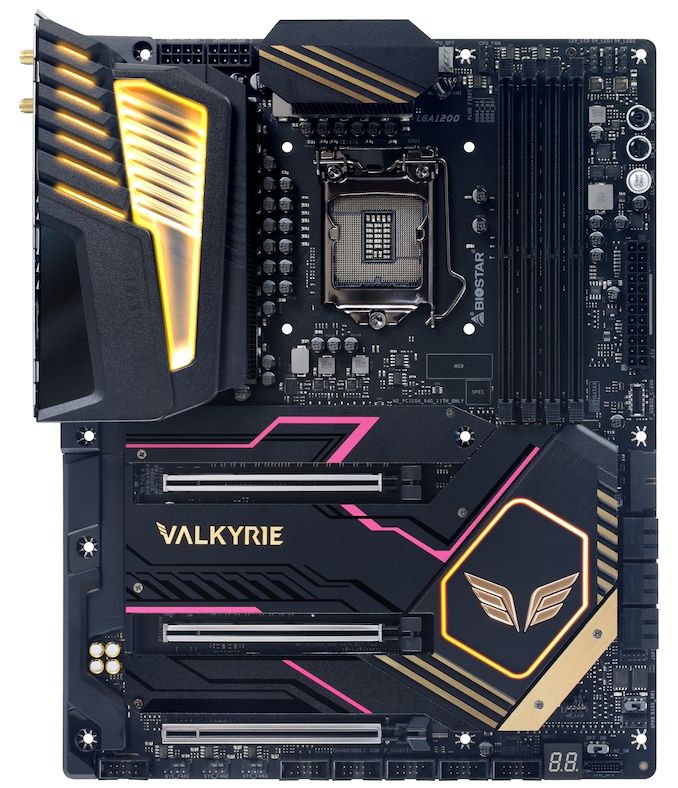The Intel Z590 Motherboard Overview: 50+ Motherboards Detailed
by Gavin Bonshor on January 19, 2021 10:15 AM ESTBiostar Z590 Valkyrie
Typically one of the most affordable brands in motherboards is Biostar, with its Racing inspired designs and mid-range controller sets at a competitive price point. For Intel's Z590 chipset launch, Biostar has prepared a premium model, the Z590 Valkyrie. Deriving from the Old Norse language for 'chooser of the slain,' the Z590 Valkyrie includes visually appealing pink and gold accents across the PCIe slot armor, chipset heatsink, and rear panel cover, which also includes integrated LED lighting.
Surrounded by a black, pink, and gold accented set of M.2 heatsinks and armor are three full-length PCIe slots, with two operating at PCIe 4.0 x16 and x8/x8, with a PCIe 3.0 x4 slot along the bottom. Touching more on the storage capabilities of the Z590 Valkyrie, it includes three PCIe M.2 slots, with the top slot operating at PCIe 4.0 x4, with the other two slots supporting both PCIe 3.0 x4 and SATA drives, but using SATA drives in the M.2 slot will make some of the SATA ports unavailable as they share bandwidth. Six SATA ports include support for RAID 0, 1, 5, and 10 arrays.
Biostar also includes support for up to DDR4-5000 memory, with a total capacity of up to 128 GB across four memory slots. To provide power to the CPU, Biostar is using a pair of 8-pin 12 V ATX CPU power inputs, with a handy two-digit LED debugger located in the bottom left-hand corner.
On the rear panel is a variety of input and output, with one USB 3.2 G2x2 Type-C, five USB 3.2 G2 Type-A, and two USB 3.2 G1 Type-A ports. There's a pair of video outputs, including DisplayPort 1.4 and HDMI 2.0, with five 3.5 mm audio jacks and S/PDIF optical output powered by a Realtek ALC1220 HD audio codec. Networking on the Z590 Valkyrie consists of a Realtek RTL8125B 2.5 GbE and an unspecific Wi-Fi interface. Finishing off the rear panel is a PS/2 keyboard and mouse combo port, with a preattached rear I/O shield.
Biostar hasn't provided us any information on pricing at the time of writing.












88 Comments
View All Comments
Oxford Guy - Tuesday, January 19, 2021 - link
You’ll never be able to block all the spyware with a firewall. Windows is just one component of it. Don’t forget things like stealth CPUs that are built into the CPU, like the little friend on Lando’s shoulder. Etc.lmcd - Tuesday, January 19, 2021 - link
What, the tinfoil hat isn't enough anymore? The "spyware" is just as present on any Windows era.If you want to disable built in telemetry, pay for pro and disable it in the registry. It's not hard if you're really that into privacy.
Spunjji - Wednesday, January 20, 2021 - link
@lmcd - but that would require *effort* - why waste that effort on customising a modern OS, when he could expend more effort cobbling together a barely-working platform on a 12-year-old one? 😂Makaveli - Wednesday, January 20, 2021 - link
lol all I saw in my head reading those post are "old man yells at clouds"Oxford Guy - Friday, January 22, 2021 - link
That’s due to the fact that the old man has just as much chance of getting the spyware out of Windows and CPUs (and the rest) as you lot have a chance of saying something relevant.Oxford Guy - Friday, January 22, 2021 - link
Call us when the shuttle lands, Pauline.Slash3 - Tuesday, January 19, 2021 - link
Z590 only provides six native SATA ports.ASRock's Z590 Taichi has eight ports, with two via an ASMedia ASM1061 controller.
Silver5urfer - Wednesday, January 20, 2021 - link
Got it thanks. I suppose that's how the EVGA Dark got it's 8 SATA ports too.weilin - Thursday, April 29, 2021 - link
Z590, if i remember correctly... has 30 HSIO lanes total:6 of which are dedicated to USB (and can be ganged in pairs for 20Gb/s ports)
4 more that is either USB 10Gb/s or 5Gb/s or PCIe.
2 of them which can be Ethernet or PCIe,
2 of them which can be SATA, Ethernet, or PCIe.
6 of them which can be SATA or PCIe.
10 dedicated PCIe
So everything all together means theoretically maximum of:
4 LAN ports
8 SATA ports
10 USB ports
24 PCIe ports
It's up to motherboard manufacturers to configure them as they see fit. It seems like the popular choice is to maximize USB, leave SATA at 6 and put the rest on PCIe ports (take 1 or 2 away for Ethernet, and 4 away for Thunderbolt if present).
weilin - Thursday, April 29, 2021 - link
If anyone's interested in see the doc:https://ark.intel.com/content/www/us/en/ark/produc...
On to left its under "Technical Documentation" -> "Intel® 500 Series Chipset Family Platform Controller Hub Datasheet, Volume 1 of 2" -> bottom of page 18